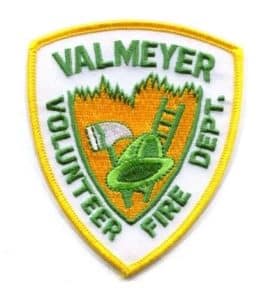New Athens EMS no more
Residents of New Athens will soon be relying exclusively on the services of MedStar Ambulance Inc. for their emergency response needs as the village’s ambulance service is shutting down, the cost to maintain the department deemed too high.
New Athens Mayor Joe Behnken offered an overview of events leading up to the closure, noting that the assistant ambulance director reported to the village board in September the Illinois Department of Public Health’s recommendation to increase staffing.
As Behnken described, the department’s part-time EMTs were only covering about 65 percent of available shifts, with calls outside those shifts handled by other agencies, namely MedStar.
In an effort to address this staffing shortage, the board increased the standby pay for responders by 40 percent in order to make it more competitive and attract more personnel.
The big issue with this change, as Behnken explained, was that there wasn’t a way to pass on the additional cost to customers with Medicare and Medicaid as there is a cap on how much can be charged for ambulance transports.
The ambulance service, in turn, lost a tremendous amount of money, reporting a $180,000 loss in the past fiscal year.
As a result, the department’s closure was recently announced, and the shift to MedStar is expected sometime in June.
“It was impossible for the village to support those operating losses,” Behnken said. “The village would have gone bankrupt.”
Along with the general cost of wages and the aforementioned Medicare and Medicaid cap, one of the issues plaguing the service Behnken identified is the fundamental lack of demand.
“The service is unsustainable,” Behnken said. “A couple of reasons. Number one is, of course, the wages. Number two is the cap. But number three is the demand has dropped substantially because our home for the aged in the village of New Athens is closed. That was about 20 percent of the business.”
He expanded on this demand issue, suggesting one contributing factor is changing demographics as baby boomers who have supplied ample demand are now dying.
He also put the demand issue in numeric terms, saying that the village’s ambulance service currently conducts about 0.7 transports each day.
Behnken contrasted this with the service in East St. Louis, which he said sees about 0.8 transports every hour.
“If you don’t have that critical mass, you cannot sustain the labor force,” Behnken said. “We can’t man the base with two EMTs 24 hours a day, seven days a week with 0.7 transports per day. It’s basically a statewide problem.”
Behnken added that the village is currently in the process of assigning the ambulance service contract to MedStar.
MedStar CEO and Vice President Charles Kelly also spoke on the situation, offering more of a regional perspective as the company has bases in Randolph, St. Clair, Clinton and Madison counties.
Kelly noted that this sort of situation is precisely how MedStar came to be. Previously, local funeral homes provided ambulance services for communities but were driven out of the industry by regulations.
As Kelly described, his father was able to get a bank loan in order to begin offering ambulance coverage through MedStar.
Kelly also spoke about the various issues he sees with the industry.
He noted how, just like with local fire departments, EMS departments and ambulance services are greatly wanting staff, volunteer or otherwise.
“This is a nationwide problem, and it is growing incredibly fast,” Kelly said. “COVID really did hurt us. Through the public health emergency, the number of people leaving the profession and the lack of classes coming out, the supply and demand just didn’t meet up, and now we’re kind of in a rebuilding year, I would say. We’re trying to get as much staff as we possibly can to build our numbers back up. It’s a nationwide problem. Everybody is struggling for staff.”
Another key issue is reimbursement from insurance, as such payments can often come with significant delays – if they come at all.
Kelly also suggested that ambulance services need to be able to accrue more funding from taxes.
He added that wages seem to be acceptable among the industry, though he added the work can be particularly difficult and grueling.
“It’s sad,” Kelly said. “We just keep losing more and more ambulance services. When somebody calls 911, somebody has to answer that call, but who is it gonna be and how long is it gonna be to get to them? Without appropriate funding, villages like New Athens can’t keep their ambulance together.”
Speaking on the future of ambulance service in New Athens, Kelly said the current plan from MedStar is to have a permanently-staffed ambulance in that community.
“There’s gonna be an ambulance stationed in New Athens,” Kelly said. “We’ve already worked it out that we are going to utilize their facilities where the ambulance is normally stationed. Instead of the volunteers responding from home, they’re gonna be sitting there with the ambulance and prepared to respond to a call.”
This situation would seem to be promising for response times in the community, and Behnken expressed a similarly positive sentiment, further emphasizing how much the community has already come to rely on MedStar services.
“Response times I think will be comparable,” Behnken said. “When we were at 61 percent staffing, MedStar is the one that was picking up the slack. Furthermore, just a couple of weeks ago, we had an issue at the local Casey’s… Of course, police were the first responders, and the second responders to arrive on the scene was not the New Athens ambulance service. It was MedStar.”
While Behnken didn’t discuss the possible future of the village’s ambulance service should legislative and other changes allow for greater funding and support, Kelly suggested that MedStar’s current position in New Athens will hopefully be temporary as the village finds the means for a local ambulance service.
“Long-term, I’m just trying to help them out because it’s either going to be like it is now – 911’s gonna be called, they don’t have an ambulance crew and I respond – or I help them work through it, cover them for a little while while they work through their taxing issues, and hopefully, at some point, they can build up their staffing and get it restarted back on their own,” Kelly said. “That seems to be the biggest concern is the members that have so valiantly covered that community for many years. They don’t want to see the ambulance go away, and I’m not taking their ambulances, I’m not taking their equipment, I’m just gonna be using it to help cover their community while they work out whatever they’re going to do.”






